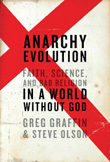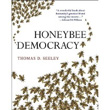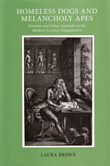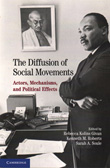BOOKS

Greg Graffin Ph.D. '03 is the lead singer for the punk band Bad Religion. See larger image
Bad Religion, reviving colonial ideals, wisdom of bees and a notorious New York murder
Punk singer Graffin, with a Cornell Ph.D., examines evolution, faith
Many people know Greg Graffin as the lead singer and songwriter of the punk band Bad Religion (above) but not as many know that he also received a Ph.D. from Cornell (2003, zoology) and that he teaches evolution at the University of California-Los Angeles. In "Anarchy Evolution: Faith, Science and Bad Religion in a World Without God" (HarperCollins, 2010), Graffin and co-author science writer Steve Olson argue that art and science have a deep connection. As an adolescent growing up when "drugs, sex and trouble could be had on any given night," Graffin discovered that the study of evolution provided a framework through which he could make sense of the world.
He describes his coming of age as an artist and the development of his worldview on questions involving God, science and human existence, including a discussion on the long-standing debate about atheism and the human condition.
As part of research for his Ph.D. dissertation, "Monism, Atheism and the Naturalist Worldview: Perspectives From Evolutionary Biology," Graffin asked 149 prominent evolutionary biologists whether they believed in God; 130 answered no, but only a handful responded that they considered science and religion to be incompatible.
Freedom on two sides of a coin
"The Two Faces of American Freedom" (Harvard University Press, 2010) by Aziz Rana, assistant professor of law, reinterprets the American political tradition from the colonial period to modern times, placing issues of race relations, immigration and presidentialism in the context of shifting notions of empire and citizenship.
U.S. citizens today are increasingly insulated from everyday decision-making, Rana says – even while the United States enjoys tremendous military and economic power. This was not always the case. America, Rana argues, began as a settler society grounded in an ideal of freedom as the exercise of continuous self-rule – one that joined direct political participation with economic independence. However, this vision of freedom was politically bound to the subordination of marginalized groups, especially slaves, Native Americans and women. These practices of liberty and exclusion were not separate currents, but rather two sides of the same coin, he argues.
By the mid-20th century, a new framework presented national and economic security as society's guiding commitments and nurtured a continual extension of America's global reach. In the book, Rana envisions a democratic society that revives settler ideals, but combines them with meaningful inclusion for those at the margins of American life.
A lesson from the bees: Rely on collective wisdom
Honeybees make decisions collectively – and democratically. Every year, faced with the life-or-death problem of choosing and traveling to a new home, honeybees engage in collective fact-finding, vigorous debate and consensus building. In fact, as animal behaviorist and neurobiology and behavior professor Thomas Seeley reveals in "Honeybee Democracy" (Princeton University Press, 2010), these incredible insects have much to teach us when it comes to collective wisdom and effective decision-making.
Each year, as a bee colony becomes overcrowded, a third of the hive rears a new queen, while the rest departs with the old queen to produce a daughter colony. Seeley describes how honeybees evaluate potential nest sites, advertise their discoveries to one another, engage in open deliberation, choose a final site and navigate together – as a swirling cloud of bees – to their new home. Seeley ponders how evolution has honed the decision-making methods of honeybees over millions of years, and points out similarities between how bee swarms and primate brains process information.
Gilded age is backdrop of sordid true-crime tale
In "Arsenic and Clam Chowder: Murder in Gilded Age New York" (State University of New York Press, Albany, 2010), James D. Livingston '52 recounts the sensational 1896 murder trial of Mary Alice Livingston, a member of one of the most prestigious families in New York (and a distant cousin of the author), who was accused of murdering her mother.
The bizarre instrument of death, an arsenic-laced pail of clam chowder, had been delivered to the victim by her 10-year-old granddaughter, and Livingston was arrested in her mourning clothes immediately after her mother's funeral. In addition to being the mother of four out-of-wedlock children, the last born in prison while she was awaiting trial, Livingston faced the possibility of being the first woman to be executed in New York's newfangled electric chair, and all these lurid details made her arrest and trial the central focus of an all-out circulation war then under way between Joseph Pulitzer's World and Randolph Hearst's Journal.
The story is set in Manhattan in the 1890s, with the arrival of skyscrapers, automobiles, motion pictures and other modern marvels which transformed urban life with breathtaking speed, amid the political battles of reformers against vice, police corruption and Tammany Hall. The story also addresses a number of social and legal issues, including capital punishment, equal rights for women, sexual mores, inheritance laws in regard to murder, gender bias of juries and the meaning of "beyond a reasonable doubt."
Animals as literary stand-ins for humanity's questions
In 18th-century England, the encounter between humans and other animals took a singular turn with the discovery of the great apes and the rise of bourgeois pet keeping. These historical changes created a new cultural and intellectual context to better understand animals, and the role of nonhuman animals in imaginative literature from that period to the present day.
In "Homeless Dogs and Melancholy Apes: Humans and Other Animals in the Modern Literary Imagination" (Cornell University Press, 2010), Laura Brown, the John Wendell Anderson Professor of English and vice provost for undergraduate education, examines how the literary works of the 18th century use animal-kind to bring abstract philosophical, ontological and metaphysical questions into the realm of everyday experience, affording a uniquely flexible perspective on difference, hierarchy, intimacy, diversity and transcendence. Among the authors whose work she discusses are: Frances Burney, Jonathan Swift, Mary Shelley, Charles Dickens, Elizabeth Barrett Browning and Paul Auster, who brings her analysis up to the present day.
Examination of how social movements spread
It is widely recognized that social movements may spread – or "diffuse" – from one site to another. This diffusion, however, is a complex and multidimensional process that involves different actors, networks and mechanisms.
This complexity has spawned a large body of literature on the diffusion process. The new book, "The Diffusion of Social Movements: Actors, Mechanisms, and Political Effects" (Cambridge University Press, 2010) edited by ILR School assistant professor Rebecca Givan, government professor Kenneth Roberts and former Cornell professor Sarah Soule, however, is one of the most comprehensive looks at the big picture.
Roberts, the Robert S. Harrison Director of the Institute for the Social Sciences, brings together Cornell social scientists from various disciplines who might not otherwise meet. Givan is a former ISS fellow.





